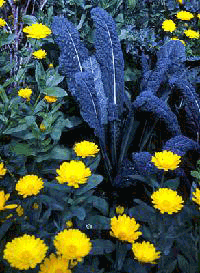
Toss Some Edibles Into Ornamentals
By Dean Fosdick, The Associated Press
Includes an interview with Marion Owen
Published Sunday, March 13, 2005
FEATURE ARTICLE:

Tom Hanks' "Power of Four" solution
More good stuff:
Who is Marion Owen?
FAQs about PlanTea
Search Marion's articles, tips and recipes
Why grow organic?
News and press releases
Read love letters
How to link to this site
Need a speaker?
How to contact Marion
Visiting Alaska?
Come to Kodiak Island!
Go to home page

Marion's UpBeet Gardener
Newsletter has been
replaced by Marion's blog
which you can find at:
www.marionowen.wordpress.com
Enough, already, about stopping to smell the roses. How about pausing to pinch off a few pods of peas or slowing to savor some strawberries? That kind of gardening can satisfy your hunger as well as soothe your soul.
We're talking edible landscaping here. Food at your feet. Blossoms bred for browsing. It's vegetables, fruits and nut-bearing plants performing double duty as ornamentals covered with blooms or colored with foliage as changeable as the seasons.

Tender and flavorful Toscana kale grows among the pot marigold plants in this attractive Kodiak, Alaska, garden. The marigold flowers are revered for their qualities as a medicinal and culinary herb. (Photo by Marion Owen)
You can mix and match with the traditional assortments of annuals and perennials, like peppering pansies with parsley; training snap peas to vine their way up raspberry canes, using berry-bearing shrubs or sweet-smelling herbs as ground cover or by planting edible roots (think sweet potato vines) for color or contrast in window boxes.
What law of nature says vegetables must grow with military precision in squared-off garden plots or that flowerbeds should flank front entries? You can squeeze more plants into a curved line, anyway. Scattering seeds or seedlings randomly around the yard also increases yield. Call the planting style "country casual."
Take the Victory Gardens of World War II as an example. Governments and many large companies promoted turning the soil as a way of boosting self-reliance and freeing supplies for troops stationed around the world. It was a grass-roots effort made all the more productive by sloganeers who came up with "Groundwork for Victory: Grow More in '44," or "Plant a Victory Garden, Our Food is Fighting."
Victory Seed Co. of Olalla, Ore., says on its Web site that "although canned foods were rationed items, there were relatively few food shortages in WWII America. The call to plant a Victory Garden was answered by nearly 20 million Americans. These gardens produced up to 40 percent of all that was consumed."
That same grow-your-own philosophy is sprouting again, except the modern-day emphasis is directed more toward avoiding the potentially harmful "cide-effects" of products dosed liberally with pesticides, herbicides or fungicides.
Gardeners also want foods rich with flavor and containing the kind of dew-draped freshness found only in sun-ripened products dropped directly into salad bowls.
"Ever since (the terrorist attacks of) 9/11, people are nesting more, spending more time and energy around the house," says Marion Owen, a merchant marine officer turned freelance photographer and author from Kodiak, Alaska.
"'Fluffing the pillows,' I call it. But here's the dilemma. On the one hand we're 'dolling up' the home and garden while on the other, leisure time has shrunk to an all-time low. We're overworked and underplayed. That means the amount of time we spend in the garden tending roses, mowing the lawn, watering tomatoes has grown more precious. As a result, we demand more from the plants. "Instead of going to the nursery and asking, 'The blooms are what color?' We're more apt to say, 'So, what else does it do?'"
Edibles can add biodiversity to any landscape arrangement, becoming in the process companion planting of a different kind.
"Growing fruit-bearing shrubs as a hedge and establishing rhubarb in a spot that would raise eyebrows during a white-gloved garden tour doesn't necessarily mean you're following classic companion planting techniques such as interplanting marigolds with beans to discourage bean beetles," Owen says.
"Edible landscaping is taking an established method and carrying it down a different road," she says. You can plant a little or you can plant a lot, an entire city lot, for that matter. But if you intend to start with a large food-bearing operation, do some diagramming as you would with any landscaping project. Check your soil; consider your many macroclimates. Then match plants to conditions.
"No space for a garden," you say? "No excuse," Owen says. "Grow up, not out." Peas and cucumbers are a couple of standards that come to mind when thinking vertical, she says.
"Because our house is on a small footprint, we maximize as much [space] as possible: 20-plus raised beds, containers on the porch. Stuff is crawling, climbing or draping hither and yon."
There's nothing shabby about developing a manicured yard bursting with flowering plants. But edible landscaping enriches you even more.
Good reads for good eats:
+ The Complete Book of Edible Landscaping by Rosalind Creasy (A Sierra Club Book, $14.95).
+ The Ohio State University Extension Web site to Ohioline Yard and Garden: http://ohioline.osu.edu/ lines/hygs.html. Scroll down to Fact Sheet Series and download Edible Landscaping (HYG-1255-02).
+ Or pick up some tips from Marion Owen's edible landscaping page at: http://www.plantea.com/edibleland.htm
![]()
Thanks for visiting and please stop by again. I'll put the coffee on!
Meet Marion Owen /// Learn about PlanTea /// Online Catalog /// Articles, Tips, Recipes /// Get free UpBeet Gardener newsletter /// Read current issue /// Listen to radio show /// Read news and press releases /// More resources and links /// Learn why 'grow organic?' /// View guidelines for retailers /// Read love letters /// Book Marion as a speaker /// Site map /// How to link to us /// Contact us /// Go to home page
PlanTea: The organic plant food in tea bags. http://www.plantea.com
Copyright ©1996 to present: PlanTea, Inc. All Rights Reserved. PO Box 1980, Kodiak, AK 99615-1980 USA
Questions or comments? marion@plantea.com Phone: Toll Free: 1-800-253-6331 (US and Canada); 907-486-2500